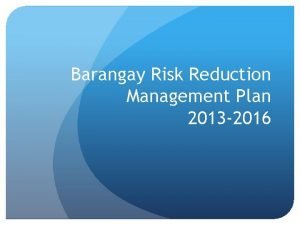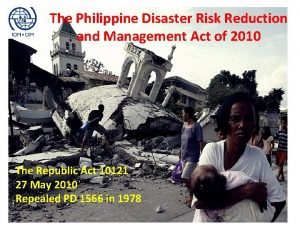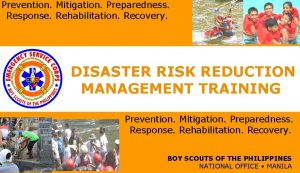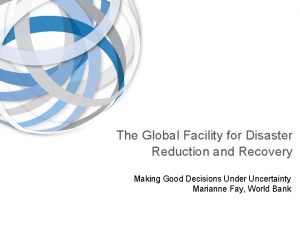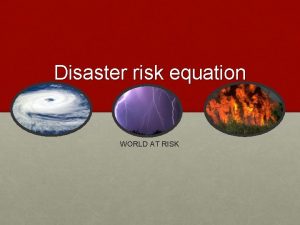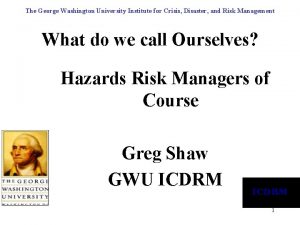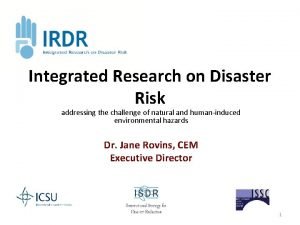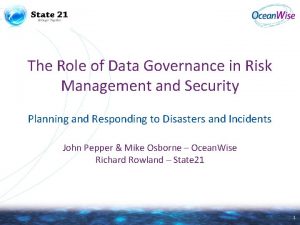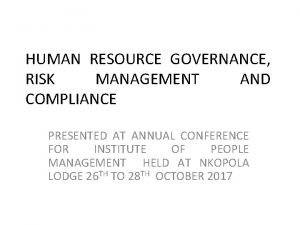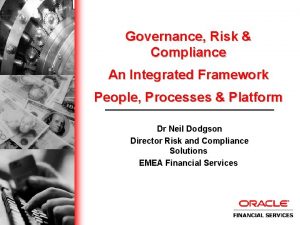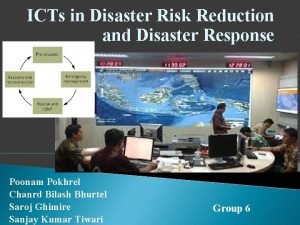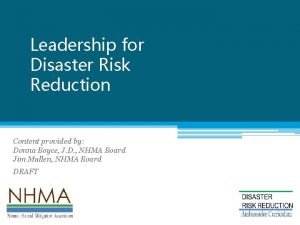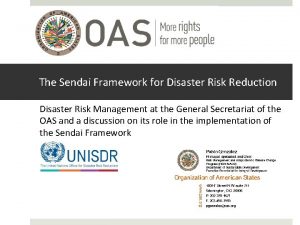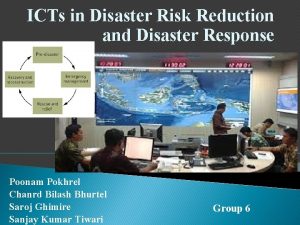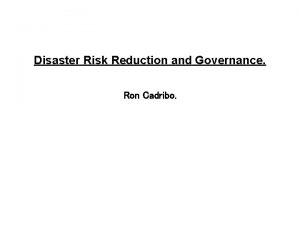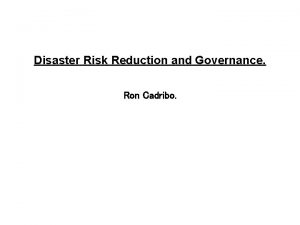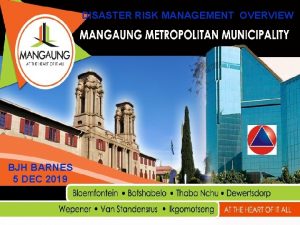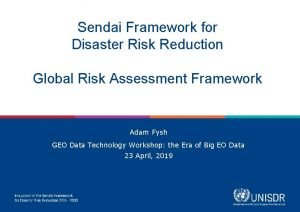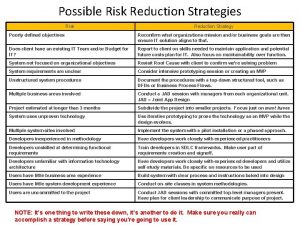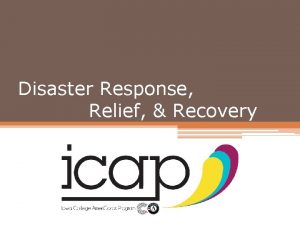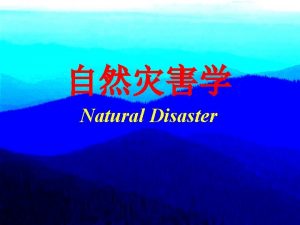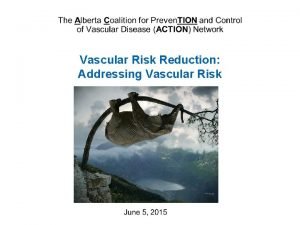Side Events Disaster Risk Reduction Government to Governance





























- Slides: 29

Side Events: Disaster Risk Reduction: Government to Governance Professional Management and Integrated Governance Peijun Shi 1, 2, 3, Ming Wang 1, 3, Jing'ai Wang 1. 4 , Qian Ye 1, 3 , Saini Yang 1, 3, Yanli Lv 1, 3 1. State Key Laboratory of Earth Surface Processes and Resource Ecology, Beijing Normal University; 2. Key Laboratory of Environmental Change and Natural Disaster, Beijing Normal University; 3. Academy of Disaster Reduction and Emergency Management, Beijing Normal University; 4. School of Geography, Beijing Normal University , Beijing, China spj@bnu. edu. cn

Contents Complexity of Disaster System Integrated Disaster Risk Governance

Contents Complexity of Disaster System Integrated Disaster Risk Governance

v 2005 U. S. Hurricane Katrina (1300 death) v 2004 Indian Ocean earthquake tsunami (275, 000 dead) v. Japan's earthquake and tsunami disaster in 2011 (15, 000 deaths) v. Myanmar typhoon disaster in 2008 (70, 000 deaths)

Response to environmental risks caused global changes is the major issue facing the sustainable development. Examples of major disasters related to climate (precipitation and temperature) Mississippi River floods in the United States in 2011 Drought disasters in south China in 2011 Hurricane Katrina disaster in the United States in 2005 Snow and ice storms in south China in 2008

Disaster System (DS) (P. Shi, 1991) • Environments (E) • Hazards (H) • Socio-economic system (S) DS=E∩H∩S 6

Socio-Ecological System and Disaster System Complexity

Multi -hazards Flood Drought Windstorm Hail Dust Storm Typhoon Low Temperature and Freeze Snow Earthquake Landslide Debris Flow 8

Disaster-chain Japan 311 Earthquake and tsunami co-triggered nuclear crisis in 2011

Earthquake - Tsunami Disaster Chain of Japan in 2011 Source: Peijun Shi et al. , 2011

China 5· 12 Earthquake Disaster Chain of Wenchuan, in 2008

Earthquake Disaster Chain of Wenchuan, China in 2008 Heavy rain Collapse Landslide Debris flow Earthquake Source: Peijun Shi et al. , 2009 Quake-lake

Hazards(Disasters) compound The large-scale sleet&snow disaster in South of China( 2008)

Multi-hazard, Disaster-chain, Hazards(Disasters) compound and LSD Multi-hazard, Disaster-chain, Hazards(Disasters) compound are often used in various references of disaster studies, but there is still different understanding about their essential difference (Shi et al. , 2010 a). Disaster-chain, Hazards(Disasters) compound triggered by a severe or enormous disaster event are generally the reason for the huge losses of LSD. The existence of multi-hazards is not a necessary condition for the formation of a LSD; only when the regional disaster prevention capacity is extremely low will it be possible to trigger a LSD.

Contents Complexity of Disaster System Integrated Disaster Risk Governance

The Nation-wide Paradigm of Integrated LSD Risk Governance in China (Top-down) Consilience between Disaster Risk Reduction and Development

Year's Loss Ratio and Death population rate Caused by Natural Disaster in China v 10 -6 v 10 v 7. 00% v 9 v 8 v 7 v. Annual Loss Ratio v. Annual Death Rate v 6. 00% v 5. 00% v 4. 00% v 5 v 3. 00% v 4 v 3 v 2. 00% v 2 v 1. 00% v 1 v 0. 00% v 1990 v 1992 v 1994 v 1996 v 1998 v 2000 v 2002 v. Year v 2004 v 2006 v 2008 v 2010 Annual economic loss to GDP ratio (expressed as percentage of GDP) and annual death rate (number of deaths per million people) caused by natural disasters in China, 1990 -2011 (excluding the Wenchuan earthquake event, 2008). Based on data from Fang et. al.

Disaster Risk Maps of CHINA Covers of the three atlases of natural disaster risk in China. Source: The People’s Insurance Company of China, 1992; Shi, 2003 and 2011.

Establishing and Improving the Disaster System ( D S) Warning Information Integration Platform Monitoring. Warning and Forecasting System Prepareness and Manage System DS Warning Information Integration Platform Material Storage and Security System

Forming integrated DS governance paradigm Governments Construction mitigation adaptation Cooperation Institute s Coordination Community Family Place Local ce n le Regional i s re Global Integration Communication Government: Development and Disaster Reduction (Governance) Community: Safety Construction (Legislation) Institute: Risk Transformation (Mechanism) Family: Risk Awareness (Education)

Consilience between Structure and Function Optimization

Consilience Model for Integrated DS Governance

Global Network of Large-Scale Disaster Impact

Improving mitigation to response ER we propose to establish “global integrated disaster risk governance paradigm” under the development strategy for “living with global climate diversity. Global Integrated Disaster Risk Governance Paradigm under Development Strategy for Living with Global Climate Diversity

Integrated Disaster Risk Governance of Climate For this reason, humans must establish corresponding defensive measures based on the integrated characteristics of CCR, improving mitigation to response ER, improving resilence to response FR and improving adaptation to response TR. Only by improving mitigation, resilience and adaptation of human beings gradually to response climate change and form cohesion of integrated CCR governance, can we promote sustainability comprehensively from local, regional to global under the background of climate change. Change

Key Points A The nature of disaster system shows the characteristics of deep complexity. The human society as a whole should fully address the deep complexity and establish governance paradigms for better and more effective disaster risk reduction. The parameters in a disaster system usually experience the slow onset change, the rapid sudden change or the fluctuation in between, and these changes can often be observed as multiple hazards, disaster chain or disaster compound

Key Points B As a traditional fashion, based on the regional variation of hazards, exposures and environments that form the essential of a disaster system, government emphasizes the various professional structure measures including safety construction, disaster relief, emergency management and risk transfer, along with professional functional measures such as preparedness, emergency response, recovery and reconstruction. However, in face of the deep complexity within the disaster system, traditional measures face significant difficulty of balancing and enhancing the efficiency and efficacy of resources used for disaster risk reduction.

Key Points This article proposes a strategy of integrated disaster risk reduction (DRR) : v. The unity of development and protection v. The equalization of technological and institutional innovation in DRR v. The synergy between professional/industrial and regional DRR implementation v. The integration of DRR structures and functions v. The systemization of all-level DRR from (inter)national plans to community actions

 Bdrrm plan message
Bdrrm plan message Drrm act of 2010
Drrm act of 2010 Republic act 10121
Republic act 10121 Sss similarity theorem
Sss similarity theorem Similarity theorem examples
Similarity theorem examples Sss
Sss Angle similarity
Angle similarity Risk management avoidance
Risk management avoidance Market risk assessment
Market risk assessment Global facility for disaster reduction and recovery
Global facility for disaster reduction and recovery Principles of disaster management
Principles of disaster management E-government vs e-governance
E-government vs e-governance Governance without government
Governance without government Difference between e governance and e government
Difference between e governance and e government Mutually exclusive vs non mutually exclusive
Mutually exclusive vs non mutually exclusive What is the disaster equation
What is the disaster equation Institute for crisis disaster and risk management
Institute for crisis disaster and risk management Integrated research on disaster risk
Integrated research on disaster risk Data governance and risk management
Data governance and risk management Oracle grc
Oracle grc Hr governance risk and compliance
Hr governance risk and compliance Integrated governance risk compliance platform
Integrated governance risk compliance platform Microsoft grc
Microsoft grc Perfect competition side by side graphs
Perfect competition side by side graphs Uil tea side by side
Uil tea side by side M&a process timeline
M&a process timeline Glass will break first on the weaker side, the side:
Glass will break first on the weaker side, the side: Side angle side theorem
Side angle side theorem Two wheels roll side by side
Two wheels roll side by side Iso 5817 welding symbols
Iso 5817 welding symbols
